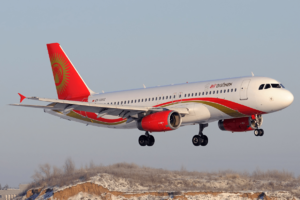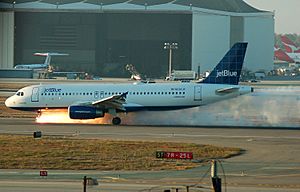Airbus A320 family facts for kids
Quick facts for kids A320 familyA318/A319/A320/A321 |
|
|---|---|
 |
|
| Lufthansa A320-211 | |
| Role | Narrow-body jet airliner |
| National origin | Multi-national |
| Manufacturer | Airbus |
| First flight | 22 February 1987 |
| Introduction | 28 March 1988 with Air France |
| Status | In service |
| Primary users | US Airways EasyJet China Southern Airlines China Eastern Airlines |
| Produced | 1988–present |
| Number built | 5,635 as of June 2013 |
| Unit cost | A318: US$67.7 million, €58 million (2011) A319: US$80.7 million, €70 million (2011) A320: US$88.3 million, €79 million (2011) A321: US$103.6 million, €95 million (2011) |
| Variants | Airbus A318 |
| Developed into | Airbus A320neo family |
The Airbus A320 family is a group of jet airliners. These planes are called "narrow-body" because they usually have only two rows of seats. The A320 family is built by a company called Airbus. It includes several different models: the A318, A319, A320, and A321. There's also a special version called the ACJ business jet, which is like a private jet.
These aircraft are made in different places around the world. They are built in Toulouse, France, and Hamburg, Germany. Since 2009, some A320 family planes have also been made in Tianjin, China, for Chinese airlines. In 2012, Airbus announced they would start making some planes in Mobile, Alabama, in the USA. These planes can carry up to 220 passengers. They can fly a long distance, from about 3,100 to 12,000 kilometers (1,900 to 7,500 miles). The exact distance depends on the specific model.
The first plane in this family was the A320. It was first announced in March 1984. The A320 had its first flight on February 22, 1987. The very first A320 was delivered to an airline in 1988. Over time, the family grew. The A321 was delivered in 1994, the A319 in 1996, and the A318 in 2003. The A320 was special because it was the first airliner to use fly-by-wire flight control systems. This means computers help control the plane. It was also the first commercial plane to use side-stick controls. A side-stick is a small joystick that pilots use to fly the plane, instead of a traditional steering-wheel-like control called a yoke.
On December 1, 2010, Airbus announced a new and improved version called the A320neo. The "neo" stands for "new engine option." This new version uses more fuel-efficient engines. It also has special wingtips called Sharklets, which help the plane fly better. The A320neo uses about 15% less fuel than the older A320. Virgin America was the first airline to order the A320neo. By the end of 2011, over 1,196 A320neo aircraft had been ordered by 21 airlines. This made it the fastest-selling commercial aircraft ever at that time.
As of June 2013, Airbus had delivered 5,635 A320 family aircraft. Most of these, 5,443, were still flying. Also, 4,014 more planes were on order. The main competitors for the A320 family are planes like the Boeing 737, 717, 757, and the McDonnell Douglas MD-80.
Contents
How the A320 Family Was Developed
The A320 was the first commercial jet in the world to use a small joystick, or sidestick, to fly it. This was different from the usual yoke, which looks like a steering wheel. This new control system worked with a digital 'fly-by-wire' system. This was the first time this technology was used in a civilian aircraft. It made the A320 much easier and safer for pilots to fly.
The A320 also has a "glass-cockpit." This means that most of the old dials and gauges in the cockpit (the front part of the plane where the pilot sits) were replaced with computer screens. Much of the technology first used in the A320 has been used in other Airbus planes built since then. Other manufacturers, like Boeing, have also started using similar technology, such as glass-cockpits and fly-by-wire, in their planes like the Boeing 777.
Understanding the A320 Design
Engines Used in A320 Planes
The A319, A320, and A321 models can use engines from two different companies. International Aero Engines (IAE) provides the V2500 engines. CFM International provides the CFM56 engines. More than half of the A320s flying today use CFM engines.
The smaller A318 model uses either Pratt and Whitney PW6000 engines or CFM56-5 engines. The PW6000 engines did not perform as well as expected. This might have led to fewer sales for the A318. Several airlines canceled their orders before the more efficient CFM engine became available for this model.
Different Types of A320 Aircraft
The original A320 design has been changed to create different sizes. It was made shorter to create the A319. It was also made longer to create the A321. More recently, it was made even shorter to create the A318. However, the A318 has not sold as well as the other versions. One of its biggest users is Frontier Airlines.
These different versions are known as "A320 derivatives." When people talk about all of them together, they often say "A320 family" or "A32x."
Airbus changes the size of the planes by adding or removing sections of the fuselage. The fuselage is the main body of the aircraft where passengers sit. They also adjust the power of the engines. Airbus tries to keep the planes as similar as possible. This helps reduce the costs for airlines to operate them.
Pilots only need one special license, called a type rating, to fly all the different A320 family planes.
Safety and Incidents
The A320 has generally been a very reliable plane. Some early problems happened because pilots were getting used to the new "glass cockpit" and "fly-by-wire" systems. These types of problems are rare now. In recent years, there have been some issues with the front landing gear of the A320.
Here are some notable incidents involving the A320 family since 1988:
- June 26, 1988: Air France Flight 296 crashed into trees during a demonstration flight in France. Three passengers died.
- February 14, 1990: Indian Airlines Flight 605 crashed while landing in Bangalore, India. 88 passengers and four crew members died.
- January 20, 1992: Air Inter Flight 148 crashed into a ridge in France during its final approach. 87 people on board died.
- September 14, 1993: Lufthansa Flight 2904 crashed at the end of the runway in Warsaw, Poland. A fire started, and the co-pilot and one passenger died.
- March 22, 1998: Philippine Airlines Flight 137 overran the runway in Bacolod, Philippines. No passengers or crew died, but three people on the ground were killed.
- August 23, 2000: Gulf Air Flight 072 crashed into the Persian Gulf while approaching Bahrain Airport. All 143 people on board died.
- May 3, 2006: Armavia Flight 967 crashed into the Black Sea near Sochi, Russia. All 113 people on board died. This was due to pilot error.
- July 17, 2007: TAM Airlines Flight 3054 could not stop while landing in São Paulo, Brazil. It crashed into a warehouse and a fuel station. All 187 people on board died, along with 12 people on the ground.
- May 30, 2008: TACA Airlines Flight 390 overran the runway in Tegucigalpa, Honduras, during bad weather. Five people died, including two on the ground.
- July 28, 2010: Airblue Flight 202 crashed into the Margalla Hills in Islamabad, Pakistan. The weather was poor. The plane hit the ground after the crew ignored warnings. All 146 passengers and six crew members died.
There have also been seven incidents where the nose landing gear had problems, including JetBlue Airways Flight 292.
Key Features of the A320 Family
| A318 | A319-100/-100LR | A320 | A321 | |
|---|---|---|---|---|
| Cockpit crew | Two | |||
| Number of passengers that can fly in the plane | 136 (maximum) 107-117 (usual) |
156 (maximum) 124-134 (usual) |
180 (maximum) 150-164 (usual) |
220 (maximum) 185-199 (usual) |
| Length | 103 ft 2 in (31.45 m) | 111 ft 0 in (33.83 m) | 123 ft 3 in (37.57 m) | 146 ft (45 m) |
| Height | 41 ft 2 in (12.55 m) | 38 ft 7 in (11.76 m) | ||
| Cruising speed | Mach 0.78 (511 mph/828 kph at 36000 ft) | |||
| Top speed | Mach 0.82 (544 mph, 876 km/h) | |||
| Ceiling (how high the plane can fly) | 39,000 ft (11,900 m) | |||
| Engines (×2) | CFM International CFM56-5 series | |||
| Pratt & Whitney PW6000 | IAE V2500 series | |||
This information comes from Airbus.
Similar aircraft
- Boeing 727
- Boeing 737
- Boeing 757
- Douglas DC-9
- McDonnell-Douglas MD-80
- Hawker-Siddley HS-121 Trident
- Tupolev Tu-154
- Tupolev Tu-204
Images for kids
-
The first A320 was delivered to Air France on 28 March 1988; the early A320-100's had no wingtip fences.
-
Lufthansa was the first to receive the stretched A321 on 27 January 1994.
-
Frontier Airlines received the first A318 on 22 July 2003.
-
An Airbus A321 on final assembly line 3 in the Airbus Hamburg-Finkenwerder plant
-
The main competition of the A320 family (background) is the Boeing 737 Next Generation (foreground).
-
The 31.44 m (103.1 ft) long A318 is the shortest variant, here in the livery of British Airways.
-
American Airlines is the largest A320 operator.
See also
 In Spanish: Familia Airbus A320 para niños
In Spanish: Familia Airbus A320 para niños



























